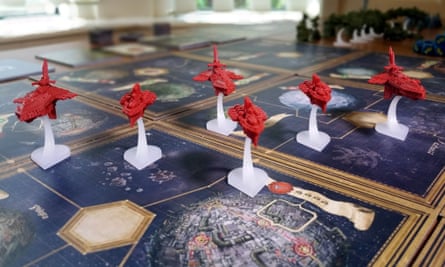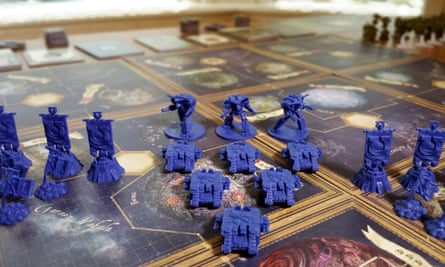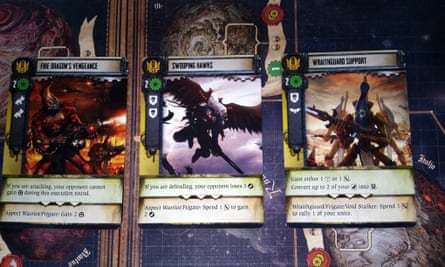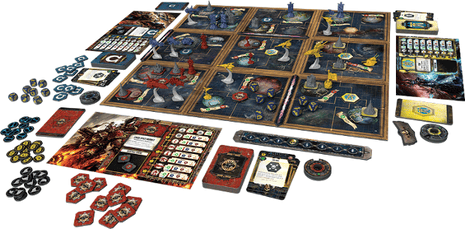If you’re remotely interested in strategy games, there’s a good chance you’re already familiar with Warhammer 40,000. In the nearly 30 years since it was first released, the science-fiction tabletop battle game has amassed legions of fans around the globe, spawned multiple video game adaptations and turned its publisher, Nottingham-based Games Workshop, into one of the biggest companies in the analogue gaming industry.
For the uninitiated: Warhammer 40,000 is a game in which players collect armies of hand-painted miniature plastic soldiers and fight battles using a complex set of rules. One of its greatest attractions is its setting – a rich, dark, gothic universe filled with war-torn worlds and populated by a multitude of belligerent alien races.
Forbidden Stars, published under licence by US studio Fantasy Flight Games, is a board game played against the backdrop of this iconic setting. It casts players as commanders of warring factions vying for control of the Herakon Cluster, a newly discovered region of space affected by dangerous cosmic storms. To claim the sector and its resource-rich planets as your own, you’ll have to build mighty ships, recruit troops, colonise worlds and fight bloody battles against opposing forces.
Let battle commence
From the moment you open its box, it’s clear that Forbidden Stars benefits from impressive production values. Almost every one of its components features beautiful and highly evocative art, and the game comes with a collection of plastic miniatures representing buildings, tanks, giant mechanical war-walkers and hulking, heavily armed spacecraft.

Players take control of four forces, each of which feels very different to play.
Space Marines are genetically enhanced, fanatically devout super-soldiers in the service of humankind’s god-emperor. They establish military dominance by steadily upgrading their units over the course of the game.
Space Orks are green-skinned marauders intent on pillage and destruction. They quickly build up their forces to overwhelm their victims with their sheer weight of numbers.
The enigmatic Eldar are graceful and elusive aliens with access to advanced technology and mysterious psychic powers.
And the hordes of Chaos are twisted and depraved humans who worship a pantheon of malevolent gods. They slowly gain control by spreading cultists from one planet to another, corrupting them for their own nefarious ends.

Whichever faction you favour, you’ll command a combination of ground units – used to seize control of planets and repel invasions by other players, and ships, which serve to ferry your troops between different areas of the board, batter opponents’ planets with devastating orbital bombardments and conduct huge battles against enemy spacecraft.
Each round of the game sees players take turns issuing secret commands to their units by placing order tokens face-down on the board, and the way in which these are resolved is one of the most interesting and challenging aspects of the game.
If players place two or more orders on the same section of the board, they form a stack with the most recently placed token on top. When all players have finished issuing commands for the turn, these chips are turned over one by one and the orders carried out.
This means the first player to place a token will be the last to act, and this can be a decidedly double-edged sword. At times you’ll issue an order only to find that your enemies’ actions render it useless. At others, you’ll sit back and watch as your foes destroy one another in combat, leaving you to drift in and claim a planet for your expanding empire with minimal opposition.
This means that timing your actions carefully and anticipating opponents’ moves becomes a huge part of the game. Get it right and you’ll feel like a tactical genius. Fail, and you’ll watch in dismay as your troops are slain and your hard-won worlds are overrun.
War of the worlds
Controlling planets is crucial in Forbidden Stars. They allow you to harvest a number of different resources that can prove invaluable to your burgeoning empire. Materiel points act as an in-game currency, allowing you to produce new units. Forge tokens let you build some of the game’s most powerful ships and ground troops. Reinforcements can give your forces a sorely needed boost in combat.
And combat is a huge part of this game.
Whenever your forces enter the same space as an opponent’s, you’ll trigger a battle that starts with each player rolling a handful of dice. These are marked with icons denoting hits and blocks, and more powerful units add extra dice to your pool. Roll more hits than your opponent manages to block and you’ll deal damage to his or her units, potentially destroying them.
But there’s far more to warfare in Forbidden Stars than dice.
Each player has a faction-specific deck of combat cards which can grant you additional hits or blocks, protect your forces from harm, force your opponent to reroll some of their dice or otherwise aid your chances of emerging victorious from a fight. This means that with clever card play, a small force can defeat a much larger one – or at least hold its ground while you frantically attempt to deploy backup.

You even have the ability to upgrade your combat deck over the course of the game, spending resources to add more powerful cards and scrap weaker ones. It feels almost like a game within a game, and carefully crafting your deck is both an art and a science.
Combat in Forbidden Stars is tense, tactical and dramatic - so it’s ironic that it’s also one of the points where the game most noticeably falls down. While battles are absolutely gripping for the players involved, they leave everyone else at the table with nothing to do until the fight is resolved, and with a bit of mental arithmetic involved in calculating the outcome, it can cause the game to drag.
And this isn’t a game that needs to be made any longer. The publisher’s site suggests that a game should take two to three hours. Our group, composed of experienced gamers, took six – and even after becoming familiar with the rules we couldn’t see ourselves getting through future sessions in less than four.
But if you’re looking for a deep, absorbing, strategic game that consumes entire evenings, this is it. If you’re a fan of Warhammer 40,000, it’s a must-buy. If you’re not, it’s still worthy of serious consideration.
- Warhammer 40,000 Forbidden Stars is currently in production and is available to pre-order from games retailers.

Comments (…)
Sign in or create your Guardian account to join the discussion